Losice
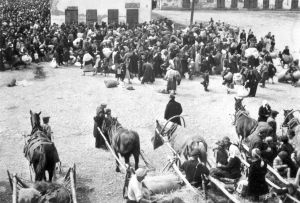
Deportation from Losice - August 1942
Losice is located 19 miles east-northeast of Siedlce and on the eve of the Second World War approximately 2,900 Jews lived in the town. The Germans occupied Losice on 12 September 1939, but seventeen days later the control of Losice passed to the Soviets, albeit for a relatively short time. The Soviet forces subsequently pulled out, in accord with the provisions of the Molotov- Ribbentrop Pact, and many Jews left Losice with them. In early October 1939, the Germans returned and re-occupied Losice, and in the initial phase the occupation was marked by general abuse of Jews, not only by the Germans, but also by some local Poles. The early persecution reached a peak, when on 29 November 1939, when seven Jews were taken to the outskirts of Losice and executed on the grounds that they were Communists.
A 10- member Jewish Council (Judenrat) was established in Losice in March 1940. The Judenrat was headed by Gershon Lewin, as chairman and also included Yehoszua (Szyja) Rozencwajg as his deputy, as well as Eliahu Rewiczer. A unit of Jewish Police, outfitted with blue hats and truncheons was established under the authority of the Judenrat, as was a post office. One of the most important functions of the Judenrat was providing the Germans with workers to perform forced labour in and around Losice. Some of the projects on which the Jews worked included the construction of barracks for the Whermacht, construction work at the Niemojki railroad station, and various jobs in Siedlce, which was the largest railroad hub in the area, in preparation for the forthcoming invasion of the Soviet Union, by the Germans.
The provision of social services was another key area of activity for the Judenrat, which included the distribution of clothing and medicine and the operation of a soup kitchen. Starting in January 1940, adult Jews received 1 kilogram of bread and children 0.5 kilogram per day. The quality of meals provided by the soup kitchen varied, sometimes consisting of soup made from only water and mashed potatoes. The demands on the Judenrat continually grew as the number of Jewish refugees in Losice from other areas steadily increased. In March 1940, more than 200 Jewish families, some 900 individuals, arrived from Lodz and Poznan and the small towns of Blaszki, Kalisz, Aleksandrow, Lodzki, and Ciechocinek. The result of the influx was that by December 1940, there were around 4,000 Jewish residents and by September 1941, this had increased to 4,600.
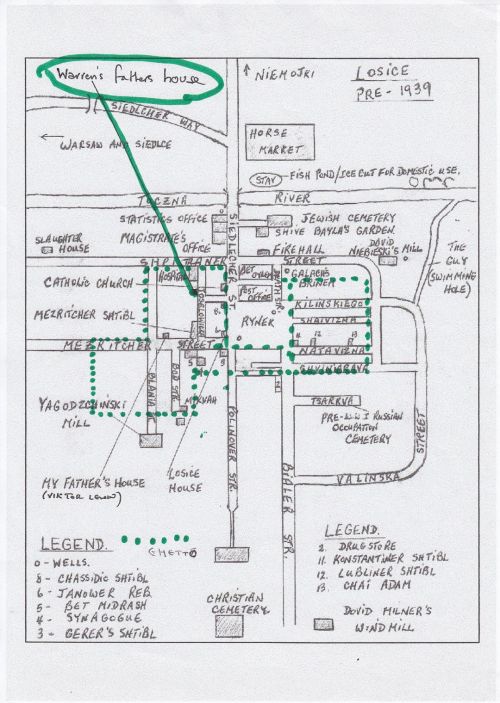
Losice pre 1939 with ghetto imposed and showing Herschel Grynberg's House - (Courtesy of Warren Grynberg)
In March 1940, a letter of protest signed by both local Jews and newly arrived refugees was sent to the American Jewish Joint Distribution Committee (AJDC) in Warsaw, to complain that the Judenrat was only acting in its own narrow interests. The letter-writers reported that Jews were dying of hunger and cold and lacked basic medical care. A month later, in April 1940, the refugees from Kalisz appealed to the ADJC in Warsaw, for a new supply of underwear and clothing. In the same month, the Judenrat received approximately 2,200 kilograms of matzot from the ADJC for distribution to refugees and others in need. In June 1940, the number of those receiving assistance from the Judenrat rose to approximately 1,300 persons, including 900 refugees. On 20 July 1940, an aid committee was constituted under the authority of the Judenrat. The chairman of the committee was Abram Wajman, a refugee from Pultusk and the deputy chairman was Aron Sztejnkloper, a member of the Judenrat. In September 1940, the committee provided meals, warm clothing, and medicine to nearly 1,600 individuals, including approximately 1,100 refugees. On 21 September 1940, Dr. D. Seid, who had been in Losice for two months, wrote a petition to the AJDC in Warsaw, calling for immediate assistance for the Jews of Losice. In response to his letter, more than 1,500 people in the town’s infirmary and in private homes received medical treatment, sometimes for a small fee, but often for free. The Judenrat continued to receive money and material aid on a fairly regular basis from the ADJC in Warsaw, as in April 1941, when the sum of 500 zloty was provided. A ghetto was created in Losice on 1 December 1941 and at its peak – in the spring of 1942 – held upwards of 5,500 Jews, including both locals and refugees from other areas. Jews in the ghetto were compelled to perform various types of forced labour, including road repair and construction, snow removal and agricultural work. There was no well located within the ghetto, and special passes were required to exit from the ghetto to fetch water.
On 16 November 1941, seven Jews were caught outside the ghetto, without passes, and were executed. With people clothed in filthy rags and living in cramped accommodation in old wooden homes that reeked of putrefaction and were overrun by lice, typhus and tuberculosis were rampant. To alleviate the situation, Seid, one of the doctors in the ghetto, planned to create a bathing and disinfection station. People sometimes congregated in a rabbi’s house for common prayer and the Germans became aware of this and abused those found participating in this activity. The relationship between the Jews in Losice and nearby Sarnaki was a peculiar one, as Jews from the latter were occasionally granted permission to visit relatives in the former, as well as to buy food and supplies at the market there. In the winter of 1941-1942, the German authorities ordered the Jews of Losice to relinquish their furs; 6 Jews chose instead to burn theirs and they were executed. Around 500 Jews from the Sarnaki ghetto were transferred to Losice in May 1942, exacerbating what was already a very strained situation in respect to provisions and space.
The Losice Judenrat received 1,000 zloty from the Jewish Self-Help (JSS) in Krakow in July 1942 and in turn requested a greater amount of aid to care for the newly arrived refugees. In the spring of 1942, some Jews who had escaped the deportations from Lublin and other locations arrived in Losice. The Germans conducted searches throughout the ghetto and executed all the escapees they found. Rumours then began to circulate that the Losice ghetto itself would soon be liquidated and its inhabitants deported. Around this time, the Judenrat was obliged to collect a ‘contribution’ of 600,000 zloty imposed by the Germans on the town’s Jews. The designated amount was paid, which led some to believe that the liquidation and deportation might be avoided. That belief was mistaken, for on 22 August 1942, when SS and Ukrainian police detachments, sealed the ghetto, marking the start of the deportation ‘Aktion.’ Jews were rounded up in the town square, in preparation for a forced march to the railway station in Siedlce, although some Jews went into hiding, and avoided the Germans dragnet. A number of Jews, however, were executed both in and around Losice and during the march to Siedlce. The Jews from the Losice ghetto who reached Siedlce, approximately 5,000 in total, were subsequently deported to the Treblinka death camp.

Losice Market Square (Ghetto Fighters House)
Following the August deportation ‘Aktion’ the ghetto was reconstituted as a ‘small ghetto’ or remnant ghetto, which housed between 200 and 300 Jews who had avoided the deportation. The remnant ghetto was also intended to lure any remaining Jews in hiding to come out in the open, as the German authorities announced that anyone returning to the ghetto would not be punished. Gathering and sorting the possessions of those who had already been deported represented the primary work for those Jews in the ‘small ghetto.’ However, on 27 November 1942, the ‘small ghetto’ was liquidated and its inhabitants were deported from Losice to Siedlce, and from there onto the Treblinka death camp. Despite the Nazis brutal efforts, some Jews from Losice were able to avoid the deportations and inevitable death. For example Chaya Gitla Zylbersztajn and her daughter Stella escaped during the ‘Aktion’ in Loscie in August 1942, and although Chaya was killed, Stella was given shelter by a number of different Polish families and ultimately survived. Sara Riwwner, formerly Weiman, who was only 9 years old in 1942, likewise survived, thanks to the refuge provided for two years by Roman and Maria Perycz. Eddie Weinstein, who was deported to Treblinka death camp in August 1942 from Losice, managed to escape from the camp, and hid in an underground bunker on the nearby Wozniki estate
Losice - Modern Day Photographs
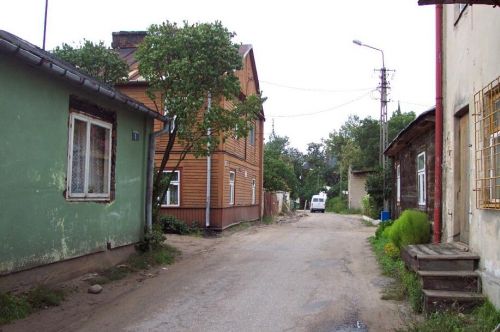
Ulica Berka Joselvitch - Grynberg family lived at No 9
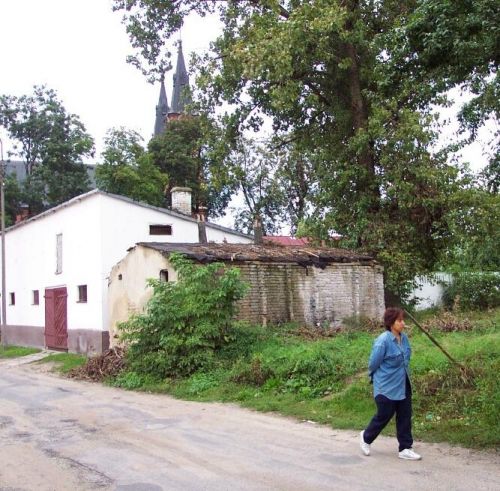
Ulica Berka Joselvitch- St Sigmund Church and Marilyn Grynberg
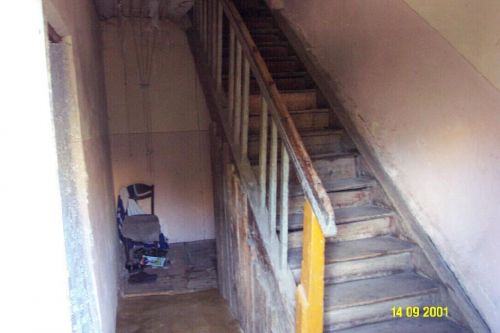

2 photographs of Ulica Berka Joselvitch
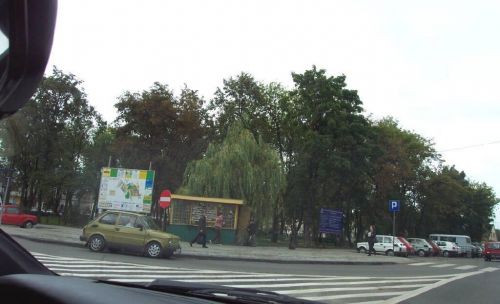
Rynek -Town Square now a public garden
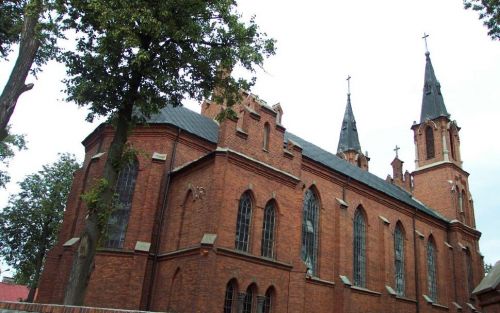
St Sigmund Church
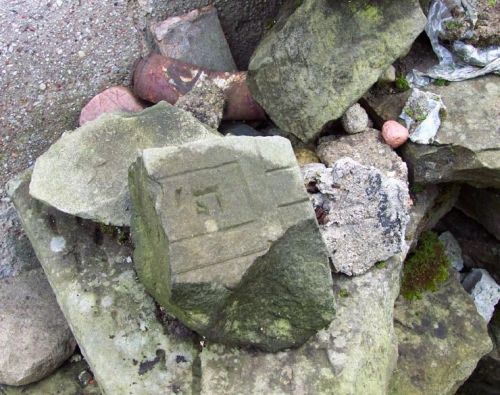
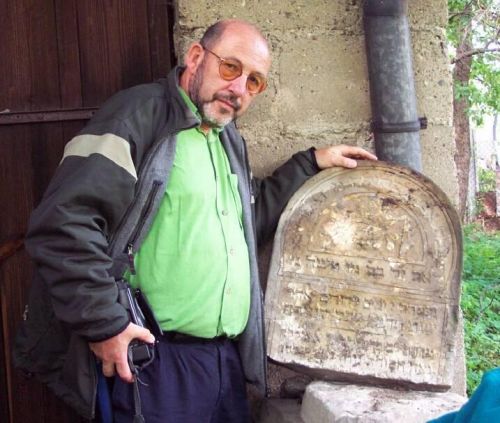
2 photographs of the Grave stones found in the Dentist's backyard

Treblinka Death Camp - Former site - Losice Memorial Stone

Ulica Berka Joselvitch - Grynberg family house site - with new buildings
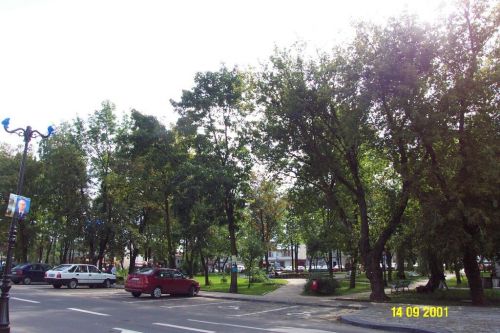
Market Place - now a public garden
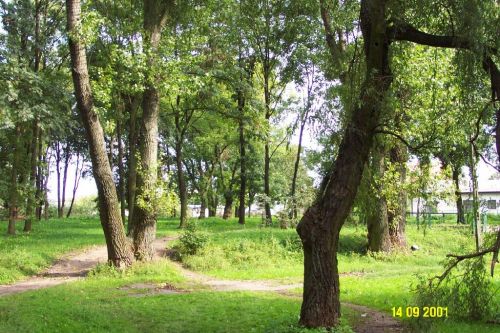
Former Jewish Cemetery - Now a public park
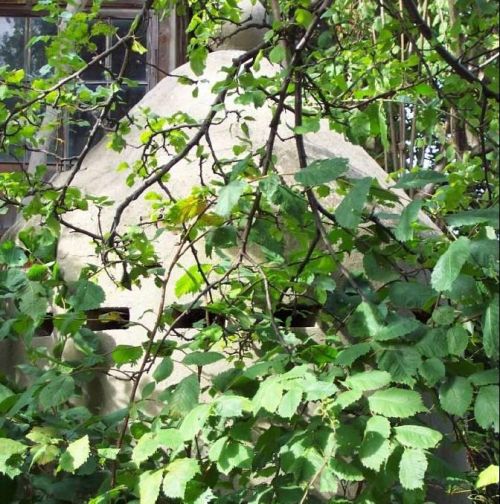
Former Nazi Bunker - Gun sites still visible

Toczna River where on Yom Kippur Jews went to pray and wash away their sins
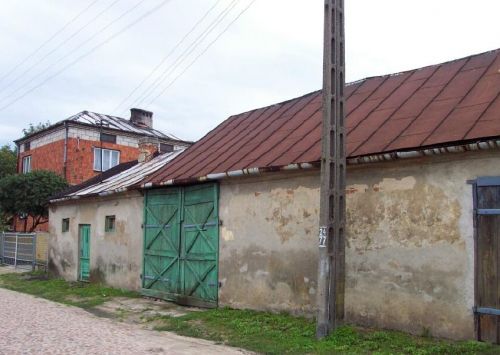
Warren's grandfather's barn where cows, goats and chickens kept.
Modern Day Photographs of Losice (Kindly supplied by Warren Grynberg)
Sources:
The Encyclopedia of Camps and Ghettos 1933-1945, USHMM Indiana University Press 2012
Y.Arad, Belzec, Sobibor, Treblinka, Indiana University Press, Bloomington and Indianapolis 1987
E.Weinstein, 17 Days in Treblinka, Yad Vashem Publications, Jerusalem, 2008.
Photograph - Yad Vashem, Israel, Ghetto Fighters House
Modern Day Photographs of Losice (Kindly supplied by Warren Grynberg)
Drawing - Courtesy of Warren Grynberg
© Holocaust Historical Society January 31, 2021

